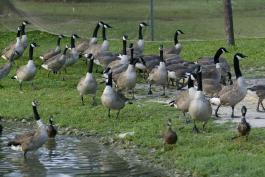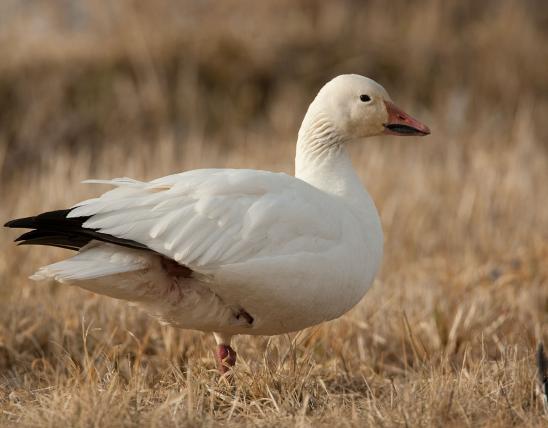
Canada geese have a grayish-brown or tan body, usually with lighter-colored underparts. The long neck and head are black, as are the legs and webbed feet. A white chin patch extends along the sides of the head to the ears. During migration, they fly in chevrons (V-shaped groups).
The giant Canada goose subspecies (Branta canadensis maxima) is resident in Missouri and much of the Midwest. Other subspecies appear in our state as seasonal migrants. Compared to other subspecies, individuals of the giant subspecies are larger, have a deeper voice, have a paler belly, have the brownish body coloration extend higher on the neck, and have the white cheek patch extend as far as the lower bill.
Length: 24–48 inches (tip of bill to tip of tail).

Common statewide on ponds, lakes, and marshes. In the coldest winters, fewer Canada geese stay in northern Missouri.
Habitat and Conservation
Canada geese live on farm ponds, lakes, and marshes. They may be found in and around nearly any body of water surrounded by large open areas of low grass, for example, at city parks, golf courses, and so on.
Once close to extinction, the Canada goose's "giant" subspecies has made an amazing recovery. Restoration of giant Canada geese in Missouri began during the late 1940s and early 1950s. Initial restoration attempts occurred on Conservation Department lands but was later expanded to private lands at the request of private landowners. The primary method used during restoration was to relocate groups of 6- to 9-week-old goslings. The goslings would usually remain in the general location where they learned to fly, and it would become their home area where they would later nest.
Food
Canada geese are herbivore grazers, feeding on aquatic vegetation, tender grasses, and various other plants and seeds, as well as insects and aquatic organisms.
Geese use a variety of wetland plants for food; but compared with ducks, they are primarily grazers of mowed or grazed upland grasses. Pastures are commonly used in rural areas, and the manicured and fertilized grasses of lawns and golf courses are highly preferred in urban settings.
During late summer and fall, the diet of geese includes more seeds. Geese are adept at stripping seeds from mature heads of grasses such as bluegrass and crab grass. During fall through early spring, agricultural crops such as corn, wheat, and milo become important food sources.
Status
Locally common summer resident on farm ponds, lakes, and marshes; common migrant and winter resident throughout the state.
Life Cycle
Pairs bond in the spring as early as their second year of life and stay together for life (if one is killed, the other may find another mate). By their fourth year, nearly all are breeding.
Nests are constructed on the ground near water: open cups of dried grasses and other vegetation and lined with feathers. Usually 3–8 eggs are laid; these are incubated for 25–28 days. Adults lose their flight feathers during incubation and cannot fly for nearly a month.
Within a few days of hatching, the young are able to leave the nest and walk and swim. Brood-rearing takes place on or near permanent water such as lakes, rivers or large permanent wetlands. Goslings are flightless for about 10 weeks and are restricted to feeding areas within walking distance of water.
There is 1 brood a year. Canada geese begin to gather in flocks in late summer. The young do not leave their parents until after the spring migration.
A Canada goose can live to be at least 33 years old.
Control
Human Connections
The sight and sound of migrating Canada geese flying overhead signals spring and autumn across North America.
Canada geese can be so numerous they can cause problems from overgrazing, abundant droppings, collisions with aircraft, destruction of newly sprouted crops, and more. Thus they can be a nuisance to landowners, golfers, park supervisors, and others.
Canada geese are popular among waterfowl hunters. More than 2.5 million Canada geese are harvested each year in North America.
The Migratory Bird Treaty Act protects these geese, their nests, and eggs, but the Missouri Department of Conservation can issue permits to help control nuisance geese.
Ecosystem Connections
Many predators feed on the eggs and young. Adults, especially when old or injured, may be eaten by bald eagles, large owls, coyotes, and other predators.
Canada geese are important grazers in wetlands statewide. When they and other waterfowl gather in large numbers in wetland staging areas along migration routes, their impact as grazers is magnified.
Just as pair bonding helps geese parents raise their young successfully, joining together in flocks helps each goose survive the winter migration.














Where to See Species
About 350 species of birds are likely to be seen in Missouri, though nearly 400 have been recorded within our borders. Most people know a bird when they see one — it has feathers, wings, and a bill. Birds are warm-blooded, and most species can fly. Many migrate hundreds or thousands of miles. Birds lay hard-shelled eggs (often in a nest), and the parents care for the young. Many communicate with songs and calls.




























